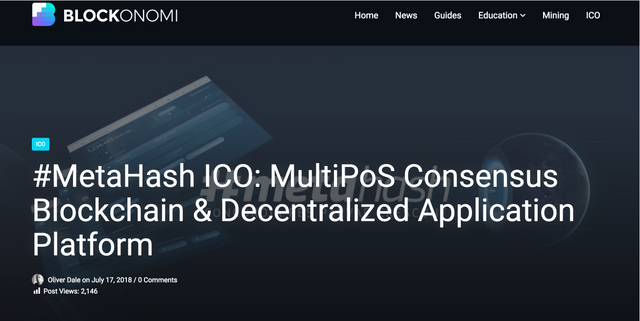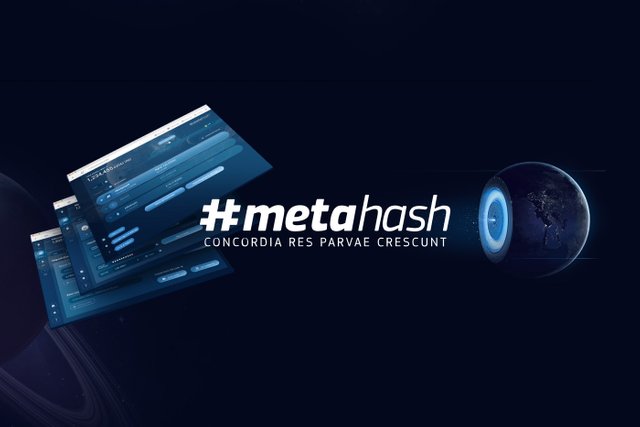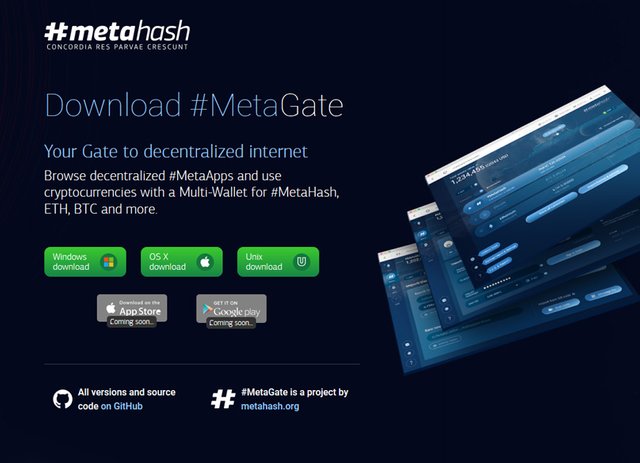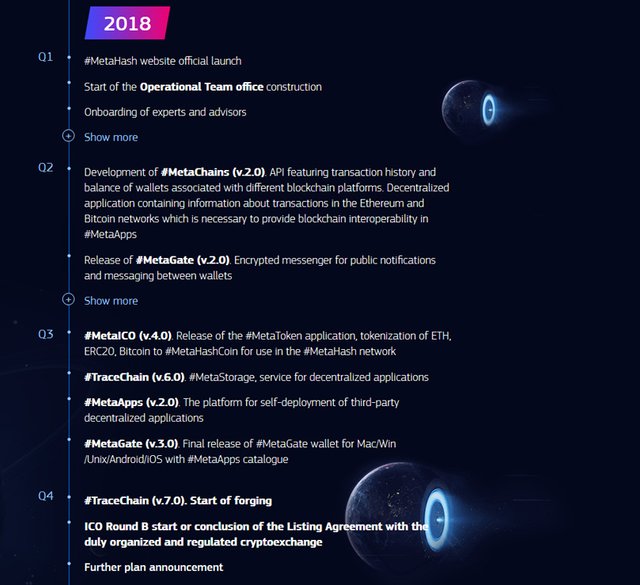[Repost] #MetaHash ICO: MultiPoS Consensus Blockchain & Decentralized Application Platform
This is a re-post from Blockonomi by Oliver Dale on July 17, 2018 in accordance with the bounty campaign of #metahash: https://bitcointalk.org/index.php?topic=4415424.0

#MetaHash is a Swiss-registered MultiPoS consensus blockchain and decentralized real-time application platform. Moreover, #MetaHash aims to integrate blockchains with one another, creating a decentralized platform for a new style of Internet. #MetaHash views its system as both a replacement for and an upgrade to the smart contract paradigm.
The ultimate goal is decentralized applications that work seamlessly, in real-time, with one another like traditional Internet offerings.
.jpg)
“The self-regulating #MetaHash network, in fact, creates a basis for the emergence of a fully-fledged branch of the decentralized Internet,” the development team wrote in the project’s white paper. “It doesn’t depend on individual creators once launched and is managed by open voting of users or #MetaHashCoin (#MHC) holders. A full decentralized Internet would bring freedom from the control of large corporations. Project managements would be in the hands of end users.”
How Does It Work?
There are four main elements to the #MetaHash network. #TraceChain is #MetaHash’s answer to the transaction speed problems facing extant blockchains. It is an automatic self-learning algorithm for signal routing, with beginning speeds of around 50,000 transactions per second. #MetaHash claims that the system is infinitely scalable as the #MetaHash network grows in the number of nodes and processing power.
The next element of the #MetaHash network is #MetaApps. #MetaApps’ code prioritizes network resources and node owners’ financial motivation to optimize the location of application copies. Essentially, developers’ apps will be voted on by #MetaHashCoin holders according to those holders’ values.
#MetaGate browser serves as the portal by which developers can access the #MetaHash network, and the #MetaHashCoin itself is the network’s native currency.
What Sets #MetaHash Apart?
The developers address #MetaHash’s similarity to other platform projects in their white paper:
“We couldn’t find any project focused on creating a fully decentralized and synchronized network capable of quickly processing data on a large-scale, global basis, so we created #MetaHash,” the developers wrote. “Many of the current projects feature clear and useful ways of application yet fail to fully meet the needs of the market.”
The developers then went on to list the market needs that #MetaHash serves. Chief among these are full decentralization, full synchronization, low prices, transaction speeds under three seconds, and high bandwidth.
As the team pointed out in their white paper: “The longer a transaction takes, the less convenient it is to use the system, and the more difficult it is for decentralized applications to run in full capacity.”
In the end of June, #MetaHash has opened its MainNet, following months of load tests which showed results above initially declared capacity of more than 50,000 tx/s with under 3 seconds validation, and started distributing #MHC prior to its upcoming start of forging initiatives. Owners of #MHC will become the first nodes contributing into the network’s growth and enjoying the full advantages of the early forging, scheduled for August, 2018.

In comparison to mining, forging does not require hardware with lots of computational power like ASICs or video cards. The protection of the network consensus is based on the value of the network native coins, which is enough to rent any common web-server, or use a home PC that has a good internet connection.
According to project’s white paper, “50% of all rewards for forging are distributed among #MHC owners, while 40% are granted to nodes’ owners. The left 10% are used for rewarding the active users of the #MetaGate browser. Coin holders can also entrust their voting rights to their own nodes or may give their voting right to the operator of the node they trust and get a share of the commission. In this way, large numbers of votes are concentrated at nodes that the community trusts, making attacks on the system more difficult.”
It will be interesting to see how this develops with the launch of more of the ecosystem.
Who Is the Team Behind #MetaHash?
#MetaHash can be thought of as a conglomerate consisting of three different companies and their respective leaders. The first co-founder profiled in the team’s white paper is Gleb Nikitin, founder of automated ad placement system AdSniper. The second is Adnow CEO Vladimir Bashkin, and the third is investment firm leader Anton Agranovsky. The teams behind each respective company all contribute to the development and operation of #MetaHash. Although the project is registered in Switzerland, much of the development team’s collective experience is in the Russian market.
What’s the Market Look Like?
#MetaHash is in the process of holding an initial coin offering, and the company lists its current #MHC price as just $0.0391 per each (can be purchased in ETH and BTC converted at the exchange rate at the time of purchase). The coin’s total supply is expected to be 9.2 billion, issued over the next 10 years.
New coins are created via the forging process, as the developers described in their white paper.
“Forging rewards come from the forging pool and transaction commissions,” the developers wrote. “Rewards are calculated every six hours when a new block (trim) is formed. The frequency of calculations and payments may vary depending on technical requirements, at the discretion of the #MetaHash Team. Unlike the proof-of-work system, #MetaHashCoins forging servers don’t go out of date and don’t lose their effectiveness, as their number is limited and depends on #MHC stakes.”
What’s Next on the #MetaHash Roadmap?
As a development platform, it’s difficult to predict what exactly the future holds for #MetaHash. By August, the #MetaHash team expects to begin forging coins. Thus paving the way for the launch of a fully decentralized system in the first quarter of 2019.

Conclusion
#MetaHash still being in development, it will be interesting to see how the final system succeeds. The main selling point of the system is its speed, although the wallet and browser they have developed for users of DApps on their platform also benefit the end user. In terms of said speed, it certainly seems that they are living up to the hype.
Although the team explains that testing is still the name of the game for their roadmap right now, they also explain the backup strategies and contingencies in the event that tweaks need to be made. While it is a work in progress, it certainly looks promising from a tech and investment perspective.
You can view the project’s website and read the white paper.
Project Media Links:
Website
Whitepaper
Onepaper
Bitcointalk ANN
bitcointalk: xiaolol123
https://bitcointalk.org/index.php?action=profile;u=1961620
ETH Address: 0x34fdB8b70A0B953E813755B9629213b32D684c7b